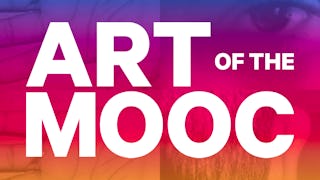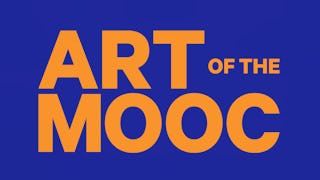Students of this course may try their hand at their own public art interventions, or simply focus on learning from the theory of public practice and its recent history. Designed by artist and Duke professor, Pedro Lasch, and co-taught by Creative Time artistic director, Nato Thompson, this course presents public culture and art in their radically reinenvented contemporary forms. The lectures link major developments of recent decades to wider topics like spatial politics, everyday social structures, and experimental education.


Ends today: Lock in Cyber Monday savings with $160 off 10,000+ programs. Save now.



ART of the MOOC: Public Art and Pedagogy
This course is part of Art of the MOOC: Art, Culture, and Society Specialization


Instructors: Pedro Lasch
18,220 already enrolled
Included with
(128 reviews)
Skills you'll gain
Details to know

Add to your LinkedIn profile
9 assignments
See how employees at top companies are mastering in-demand skills

Build your subject-matter expertise
- Learn new concepts from industry experts
- Gain a foundational understanding of a subject or tool
- Develop job-relevant skills with hands-on projects
- Earn a shareable career certificate

There are 7 modules in this course
This short module provides an overview of the course's structure, working process, global community, and overall guidelines. Make sure to read it right away and refer back to it when needed.
What's included
1 video4 readings
This lesson will lay out some basic definitions and examples of public practice and socially engaged art, especially as they relate to spatial politics. We will examine the critical role that such practices have had in relation to various forms of urbanism and social planning and consider the physical and symbolic mechanisms that separate the global and the local, the urban and the rural, the visible and the invisible, citizens and immigrants, settlers and refugees. The lecture and guest presentations will provide foundation and inspiration for students’ own experiments with spatial politics.
What's included
8 videos1 reading1 assignment
The prompt, lecture and guest presentations will provide the foundation and inspiration for students’ own experiments. These student experiments were originally peer reviewed projects in the ART of the MOOC series, but have now been made entirely optional and self-reviewed. If you want to do them, we recommend you chose one of the two options (one is more social, the other more individual) and complete the optional quiz after you are done. Your project submissions and the quiz are not graded, so they will not impact your performance in the course.
What's included
2 readings2 assignments
By definition, social art is a collective endeavor. It might seek to transform larger social structures and economies. Perhaps more modestly, it might offer some alternatives or simply confront immediate challenges. The production of an unusual, creative, or engaged collective body can be its final goal. In this lesson we will learn how socially engaged artists have used the guise or actual form of organizations and institutions such as churches, corporations, banks, government offices, and other social units as the very media of their work. This lesson’s practical components will ask students to invent their own alternative social structures or fictional interventions.
What's included
9 videos1 assignment
The prompt, lecture and guest presentations will provide the foundation and inspiration for students’ own experiments. These student experiments were originally peer reviewed projects in the ART of the MOOC series, but have now been made entirely optional and self-reviewed. If you want to do them, we recommend you chose one of the two options (one is more social, the other more individual) and complete the optional quiz after you are done. Your project submissions and the quiz are not graded, so they will not impact your performance in the course.
What's included
2 readings2 assignments
Many socially engaged artists are invested in the communication of ideas through education or educational projects. From Freire and Boal to Judy Chicago and Miriam Shapiro’s Womanhouse and the CalArts Feminist Art Program a brief review of experimental or radical pedagogy and its influence on art is hence the focus of this lesson. Using various technologies and social forms, some of these works set out to transform education from within. Others intentionally position themselves as self-organized platforms outside of institutions. Our focus will be on how the production of alternative communities of learning can challenge the hierarchies, professionalization, homogenization, and economy of current education systems. This week’s practical components will invite students to rethink their relationship to education as they chose between small-scale socialization and massive collaboration.
What's included
6 videos1 reading1 assignment
The prompt, lecture and guest presentations will provide a foundation and inspiration for students’ own experiments with spatial politics.The prompt, lecture and guest presentations will provide the foundation and inspiration for students’ own experiments. These student experiments were originally peer reviewed projects in the ART of the MOOC series, but have now been made entirely optional and self-reviewed. If you want to do them, we recommend you chose one of the two options (one is more social, the other more individual) and complete the optional quiz after you are done. Your project submissions and the quiz are not graded, so they will not impact your performance in the course.
What's included
3 readings2 assignments
Earn a career certificate
Add this credential to your LinkedIn profile, resume, or CV. Share it on social media and in your performance review.
Instructors


Explore more from Music and Art
 Status: Free Trial
Status: Free TrialDuke University
 Status: Free Trial
Status: Free TrialDuke University
 Status: Free Trial
Status: Free TrialDuke University
 Status: Free Trial
Status: Free TrialDuke University
Why people choose Coursera for their career




Learner reviews
128 reviews
- 5 stars
80.46%
- 4 stars
14.84%
- 3 stars
3.90%
- 2 stars
0%
- 1 star
0.78%
Showing 3 of 128
Reviewed on Nov 9, 2020
I loved this. The class was very informative and enjoyable. I didn’t realize I would move through the course so fast. Will be taking more courses.
Reviewed on Aug 12, 2020
This course was excellent. The content was really engaging, the tutors were very responsive and the assignments were interesting. I would wholeheartedly recommend it.
Reviewed on Dec 10, 2017
Interesting perspective on art I hadn't considered prior to this course. Thanks so much.

Open new doors with Coursera Plus
Unlimited access to 10,000+ world-class courses, hands-on projects, and job-ready certificate programs - all included in your subscription
Advance your career with an online degree
Earn a degree from world-class universities - 100% online
Join over 3,400 global companies that choose Coursera for Business
Upskill your employees to excel in the digital economy
Frequently asked questions
No. Completion of a Coursera course does not earn you academic credit from Duke; therefore, Duke is not able to provide you with a university transcript. However, your electronic Certificate will be added to your Accomplishments page - from there, you can print your Certificate or add it to your LinkedIn profile.
To access the course materials, assignments and to earn a Certificate, you will need to purchase the Certificate experience when you enroll in a course. You can try a Free Trial instead, or apply for Financial Aid. The course may offer 'Full Course, No Certificate' instead. This option lets you see all course materials, submit required assessments, and get a final grade. This also means that you will not be able to purchase a Certificate experience.
When you enroll in the course, you get access to all of the courses in the Specialization, and you earn a certificate when you complete the work. Your electronic Certificate will be added to your Accomplishments page - from there, you can print your Certificate or add it to your LinkedIn profile.
More questions
Financial aid available,



